Post-Translation Features
After the translation is complete, you can perform the following tasks:
| Column |
Description |
Details |
| import translated content |
When the translation project is complete and has been returned to the Connector, its project status is 100%. It is ready to import into Optimizely, where you can review it. You can import all available translated content, or translated content only in specific target languages. |
Importing Translated Content |
| reviewing translated assets |
After you import translated content from the Connector into Optimizely, the corresponding translated assets are ready for review. |
Reviewing Translated Assets |
| publish translated assets |
After you review translated assets, you can publish them via the Connector. You can publish all available imported assets, or imported assets only in specific target languages. |
Publishing Translated Assets |
| archiving and unarchiving projects |
You can archive projects to remove them from the default view of the Connector. |
Archiving and Unarchiving Projects |
| removing projects from the Connector |
You can remove a project from the Connector if it is in Draft, Imported, Cancelled or Published status. |
Removing Translation Projects from the Connector |
1 - Importing Translated Content
When the translation project is complete and has been returned to the Connector, the translated content is ready to import into Optimizely, where you can review it.
You can import a project even if it has not been fully translated. However, to import and publish a page, all its dependent blocks must be translated.
The Connector automatically updates translation projects with redelivered assets. If an imported project has redelivered assets, its status is 100%/Ready for import.
There are three ways to import translated content into Optimizely:
Recommendation: After importing translated content, you should review the corresponding translated assets before publishing them. For detailed instructions, see Reviewing Translated Assets.
1.1 - Importing All Available Translated Content from the Gadget
When the translation project is complete and has been returned to the Connector, the translated content is ready to import into Optimizely, where you can review it.
In the Lionbridge Connector gadget, the clock icon  is displayed and the project-completion status is variable, greater than 10% and up to 100%.
is displayed and the project-completion status is variable, greater than 10% and up to 100%.
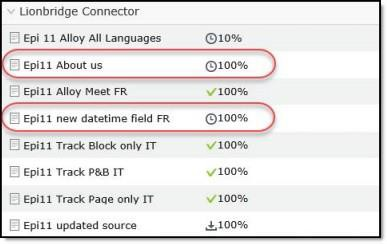
For more information about importing translated content into Optimizely, see Importing Translated Content.
To import translated content into Optimizely from the Lionbridge Connector gadget:
-
In Optimizely CMS, click Edit.

-
Click the Toggle assets pane icon.
The Assets pane is displayed on the right. The Lionbridge Connector gadget is displayed at the bottom of the pane, displaying all the translation projects.
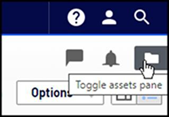
-
In the list, click a project whose status is 100% to select it.
-
Mouseover the right end of the project in the Lionbridge Connector gadget, click the Options icon  and then select Import translations in the project’s context menu.
and then select Import translations in the project’s context menu.

A message box opens, stating that the project has been imported, but that it has not been published. The project is ready for review.
-
Click OK to close the message box.
1.2 - Importing All Available Translated Content from the Dashboard
When the translation project is complete and has been returned to the Connector, the translated content is ready to import into Optimizely, where you can review it.
For more information about importing translated content into Optimizely, see Importing Translated Content.
In the Lionbridge Connector Dashboard, either:
- The displayed project status is
Ready for import.
- The project status is displayed, in italics, in
In Translation status, which indicates that some of the project content may already be ready to import into Optimizely. For more information, see the note about status displayed in italics in Monitoring Translation rojects.
To import all available translated content into Optimizely from the Dashboard:
-
In the Dashboard, locate a translation project with either Ready for import status or In Translation status, displayed in italics. This is displayed in the Status column. For information on opening the Dashboard, see Getting Started with the Connector for Optimizely.
-
In the Actions column, click the arrow and select Import All Available from the context menu.
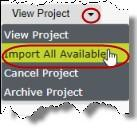
A message box opens, confirming that the project is being imported into Optimizely, and that the project status will update when the import is complete.
-
Click OK to close the message box.
1.3 - Importing Translated Content in One Target Language from the Dashboard
When the translation project is complete and has been returned to the Connector, the translated content is ready to import into Optimizely, where you can review it.
In the Lionbridge Connector Dashboard, either:
- The displayed project status is
Ready for import.
- The project status is displayed, in italics, in
In Translation status, which indicates that some of the project content may already be ready to import into Optimizely. For more information, see the note about status displayed in italics in Monitoring Translation Projects.
For more information about importing translated content into Optimizely, see Importing Translated Content.
To import translated content into Optimizely from the Dashboard:
-
In the Dashboard, locate the translation project whose content you want to import. For information on opening the Dashboard, see Getting Started with the Connector for Optimizely.
-
Click the Expand icon  on the left side of the translation project whose assets you want to import.
on the left side of the translation project whose assets you want to import.
The translation-project row expands, displaying the status of the translation of each target language in the project and any relevant actions. For a detailed description of this section, see Monitoring Translation Assets.

-
Click Import for target-language assets to import.
A message box opens, confirming that you want to import the assets in this target language.
-
Click Yes to proceed.
Another message box opens, stating that the assets were imported.
-
Click OK to close the message box.
2 - Reviewing Translated Assets
After importing translated content into Optimizely, as described in Importing Translated Content, it is ready for review. This is the recommended step before publishing.
Note: You can also review an individual translated asset by clicking its link from the Dashboard. For detailed instructions, see Viewing Translated Assets.
To review translated assets:
-
In the top-left corner of the system workspace, click the Toggle navigation pane icon  . The Navigation pane is displayed on the left.
. The Navigation pane is displayed on the left.
-
In the Navigation pane, click the Sites tab, and click the language version of the site to review. Alternatively, install the Versions Add-On to display the different language versions you have created.
-
Click the Pages tab, and in the tree structure, navigate to each page to review.
-
Optional. Click the Compare different versions icon  to compare the source and target language versions of a page side by side and review before publishing or performing further edits.
to compare the source and target language versions of a page side by side and review before publishing or performing further edits.
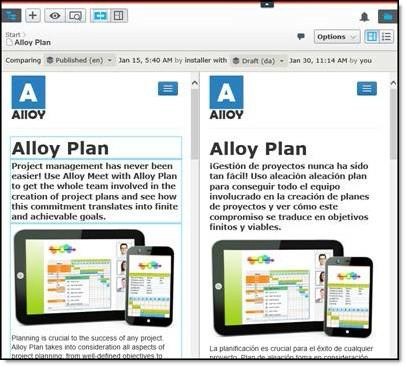
-
Optional. Click in a page to edit it.
Note: Blocks are displayed as translated within a page only after the page is published. To view the translated draft version of blocks for review purposes, in the Assets pane on the right, select the blocks, as shown below.
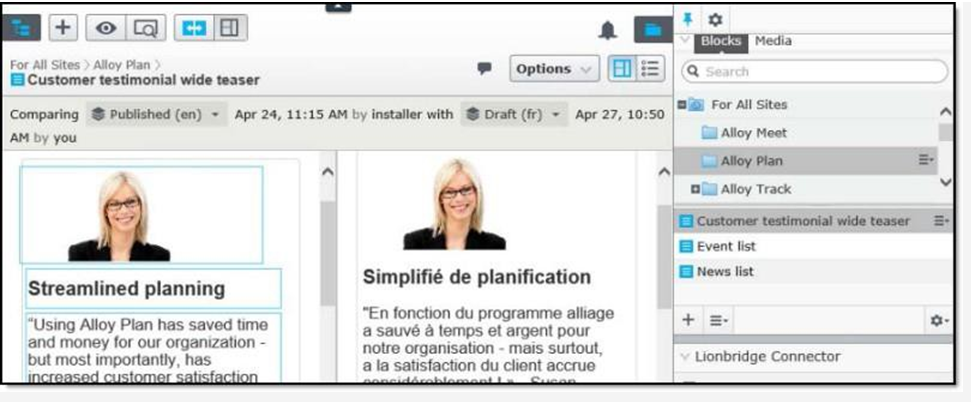
- When you are done, do one of the following to publish the translated page:
- You can click Publish? in the top-right corner and select Publish changes from the context menu.
- You can publish translated assets from within the Connector. For detailed instructions, see Publishing Translated Assets.
2.1 - Viewing Translated Assets
You view detailed information about individual translated assets in a translation project by clicking the Expand icon  next to that project in the Lionbridge Connector Dashboard (“Dashboard”), and then clicking the Expand icon
next to that project in the Lionbridge Connector Dashboard (“Dashboard”), and then clicking the Expand icon  next to an asset set for a source-target language pair. For a detailed description of the entire Dashboard, see Monitoring Translation Projects.
next to an asset set for a source-target language pair. For a detailed description of the entire Dashboard, see Monitoring Translation Projects.
To view a translated asset:
-
In the Dashboard, click the Expand icon  on the left side of the translation project whose assets you want to view. For instructions on opening the Dashboard, see Getting Started with the Connector for Optimizely.
on the left side of the translation project whose assets you want to view. For instructions on opening the Dashboard, see Getting Started with the Connector for Optimizely.
The translation-project row expands, displaying the status of the translation of each target language in the project and any relevant actions. For a detailed description of this section, see Monitoring Translation Assets.

-
Click the Expand icon  on the left side of the asset set whose assets you want to view.
on the left side of the asset set whose assets you want to view.
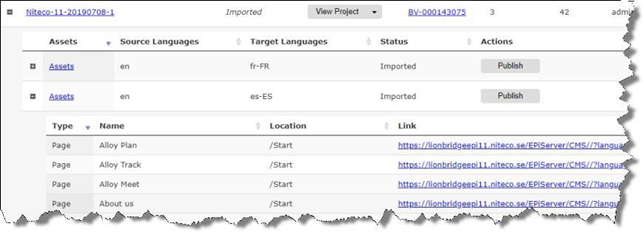
The Assets row expands, displayed the following information about each asset in the asset set:
| Column |
Description |
| Type |
The type of asset, which is either Page or Block. |
| Name |
The name of the asset in Optimizely. |
| Location |
The relative path of the translated asset in Optimizely. |
| Link |
The absolute path of the translated asset in Optimizely. |
- In the Link column, click the link to open the translated asset in within Optimizely, where you can review and edit it, and publish it if it has not yet been published.
3 - Publishing Translated Assets
After you import translated content, you can publish the corresponding assets from the Connector. Alternatively, you can publish assets individually from the regular Optimizely publishing method, as described in the last step of Reviewing Translated Assets.
Publishing translated assets from the Connector is available only when the project is in Imported status, or if it is displayed, in italics, in either In Translation or Ready for Import status, which indicates that some of the project content may already be imported into Optimizely. For more information, see the note about status displayed in italics in Monitoring Translation Projects.
To import and publish a page, all its dependent blocks must be translated.
The Connector automatically updates translation projects with redelivered assets. If a published project has redelivered assets, its status is 100%.
For instructions on importing and reviewing content before publishing it, see Importing Translated Content.
There are three ways to publish translated assets:
3.1 - Publishing All Available Translated Assets from the Gadget
After you import translated content, you can publish the corresponding translated assets.
This feature is available only when the project is in Imported status, or if it is displayed, in italics, in either In Translation or Ready for Import status, which indicates that some of the project content may already be imported into Optimizely. For more information, see the note about status displayed in italics in Monitoring Translation rojects.
For more information about publishing translated assets, see Publishing Translated Assets section.
To publish translated assets from the Lionbridge Connector gadget:
-
In Optimizely CMS, click Edit.

-
Click the Toggle assets pane icon.
The Assets pane is displayed on the right. The Lionbridge Connector gadget is displayed at the bottom of the pane, displaying all the translation projects.

-
Click a project in the list to select it.
-
Mouseover the right end of the project in the Lionbridge Connector gadget, click the Options icon  and then select Publish translations in the project’s context menu. This menu item is available only when the project is in
and then select Publish translations in the project’s context menu. This menu item is available only when the project is in Imported status.
A message box opens, confirming that the pages are being published.
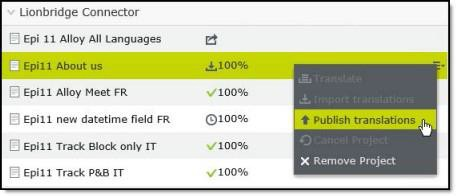
-
Click OK to close the message box.
3.2 - Publishing All Available Translated Assets from the Dashboard
After you import translated content, you can publish the corresponding translated assets.
This feature is available only when the project is in Imported status, or if it is displayed, in italics, in either In Translation or Ready for Import status, which indicates that some of the project content may already be imported into Optimizely. For more information, see the note about status displayed in italics in Monitoring Translation rojects.
For more information about publishing translated assets, see Publishing Translated Assets section.
To publish all available translated assets from the Dashboard:
-
In the Dashboard, locate a translation project with Imported status. This is displayed in the Status column. For information on opening the Dashboard, see Getting Started with the Connector for Optimizely.
-
In the Actions column, click the arrow and select Publish All Available from the context menu.
A message box opens, confirming that you want to publish all available assets in the project.
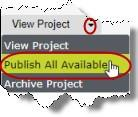
-
Click Yes to proceed.
Another message box opens, stating that the project was published.
-
Click OK to close the message box.
3.3 - Publishing Translated Assets in One Target Language from the Dashboard
After you import translated content, you can publish the corresponding translated assets. In the Lionbridge Connector Dashboard, either:
- The displayed project status is Imported.
- The project status is displayed, in italics, in either In Translation or Ready for Import status, which indicates that some of the project content may already imported into Optimizely. For more information, see the note about status displayed in italics in Monitoring Translation Projects.
For more information, see Publishing Translated Assets.
To publish translated assets from the Dashboard:
-
In the Dashboard, locate the translation project whose translated assets you want to publish. For information on opening the Dashboard, see Getting Started with the Connector for Optimizely.
-
Click the Expand icon  on the left side of the translation project whose assets you want to publish.
on the left side of the translation project whose assets you want to publish.
The translation-project row expands, displaying the status of the translation of each target language in the project and any relevant actions. For a detailed description of this section, see Monitoring Translation Assets.

-
Click Publish for target-language assets to publish.
A message box opens, confirming that you want to publish the assets in this target language.
-
Click Yesto proceed.
Another message box opens, stating that the assets were published.
-
Click OK to close the message box.
4 - Archiving and Unarchiving Projects
You archive a project so that it is no longer displayed by default in the Lionbridge Connector Dashboard (“Dashboard”). Typically, you archive a project when all its assets have been published and it is in Published status. However, you can archive any project that is not in Draft status. In contrast, when you unarchive a project, you move it to the default view of the Dashboard.
Recommendation: Archive completed projects to remove them from the default view.
To archive a project:
-
In the Dashboard, locate the project to archive.
-
In the Actions column, click the arrow for the project, and then click Archive Project.

A message box confirms that you want to archive the project.
-
Click Yes to proceed.
A message box confirms that the project is being archived.
-
Click OK to close the dialog box.
To unarchive a project:
-
In the top-left corner of the Dashboard, click the View Archived Projects button. This ensures that only archived projects are displayed.
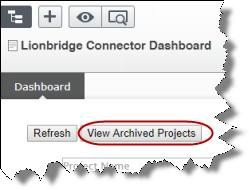
The Dashboard updates.
-
In the Actions column, click the arrow for the project to unarchive, and then click Unarchive Project.

A message box confirms that you want to unarchive the project.
-
Click Yes to proceed.
A message box confirms that the project is being unarchived.
-
Click OK to close the dialog box.
5 - Removing Translation Projects from the Connector
You can remove a translation project from the Connector. This functionality is not reversible.
This feature is available only when the project is in either Draft, Imported, or Published status. For a list and description of translation statuses, see Translation Statuses.
Notes: If you remove a project in Draft status, you will not be able to send it out for translation. This feature is not available in any other statuses, which occur when the project is actively in translation. To stop a translation project that is already in progress, you cancel the translation project in the Connector. For detailed instructions, see Canceling a Translation Project.
There are two ways to remove a translation project from the Connector:
5.1 - Removing Translation Projects from the Connector via the Gadget
You can remove a translation project from the Connector. This functionality is not reversible.
This feature is available only when the project is in either Draft, Imported, or Published status. For more information about removing translation projects from the Connector, see Removing Translation Project
To remove a translation project from the Connector in the Lionbridge Connector gadget:
-
In Optimizely CMS, click Edit.

-
Click the Toggle assets pane icon. The Assets pane is displayed on the right. The Lionbridge Connector gadget is displayed at the bottom of the pane, displaying all the translation projects.

-
Click a project in the list to select it.
-
Mouseover the right end of the project in the Lionbridge Connector gadget, click the Options icon  and then select Remove Project in the project’s context menu. This menu item is available only when the project is in either
and then select Remove Project in the project’s context menu. This menu item is available only when the project is in either Draft, Imported, Cancelled or Published status.

A message box opens, confirming that you want to remove the project.
-
Click Yes to confirm.
The project is removed from the list.
5.2 - Removing Translation Projects from the Connector via the Dashboard
You can remove a translation project from the Connector. This functionality is not reversible.
This feature is available only when the project is in either Draft, Imported, or Published status. For more information about removing translation projects from the Connector, see Removing Translation Project.
To remove a translation project from the Connector in the Dashboard:
-
In the Dashboard, locate a translation project with either Draft, Imported, or Published status. This is displayed in the Status column. For information on opening the Dashboard, see Getting Started with the Connector for Optimizely.
-
In the Actions column, click the arrow and select Remove Project from the context menu.
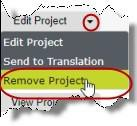
A message box opens, confirming that you want to remove the project.
-
Click Yes to confirm. The project is removed from the list.
Another message box opens, stating that the project was removed.
-
Click OK to close the message box.



 and then select Import translations in the project’s context menu.
and then select Import translations in the project’s context menu.


 . The Navigation pane is displayed on the left.
. The Navigation pane is displayed on the left. to compare the source and target language versions of a page side by side and review before publishing or performing further edits.
to compare the source and target language versions of a page side by side and review before publishing or performing further edits.










